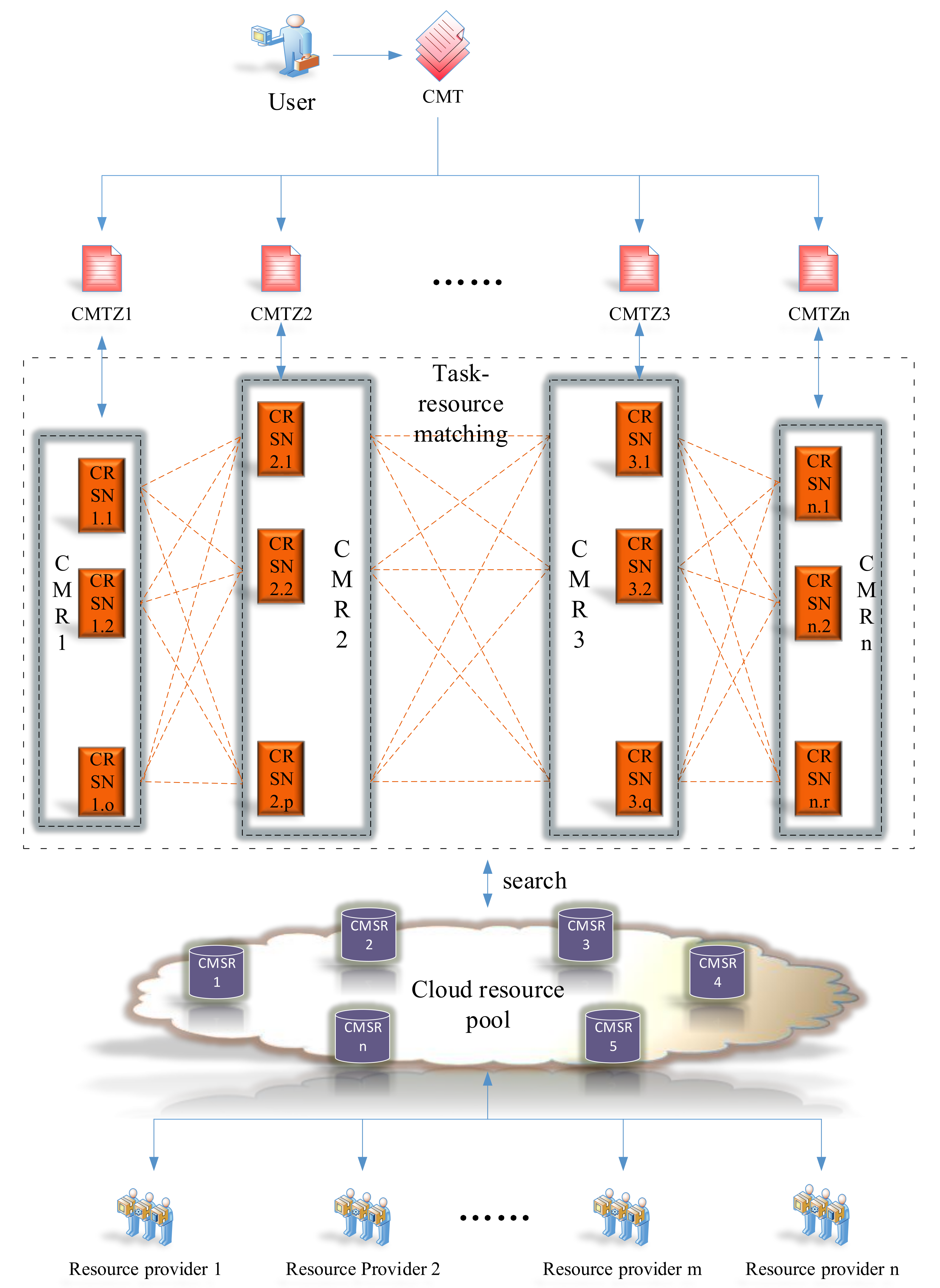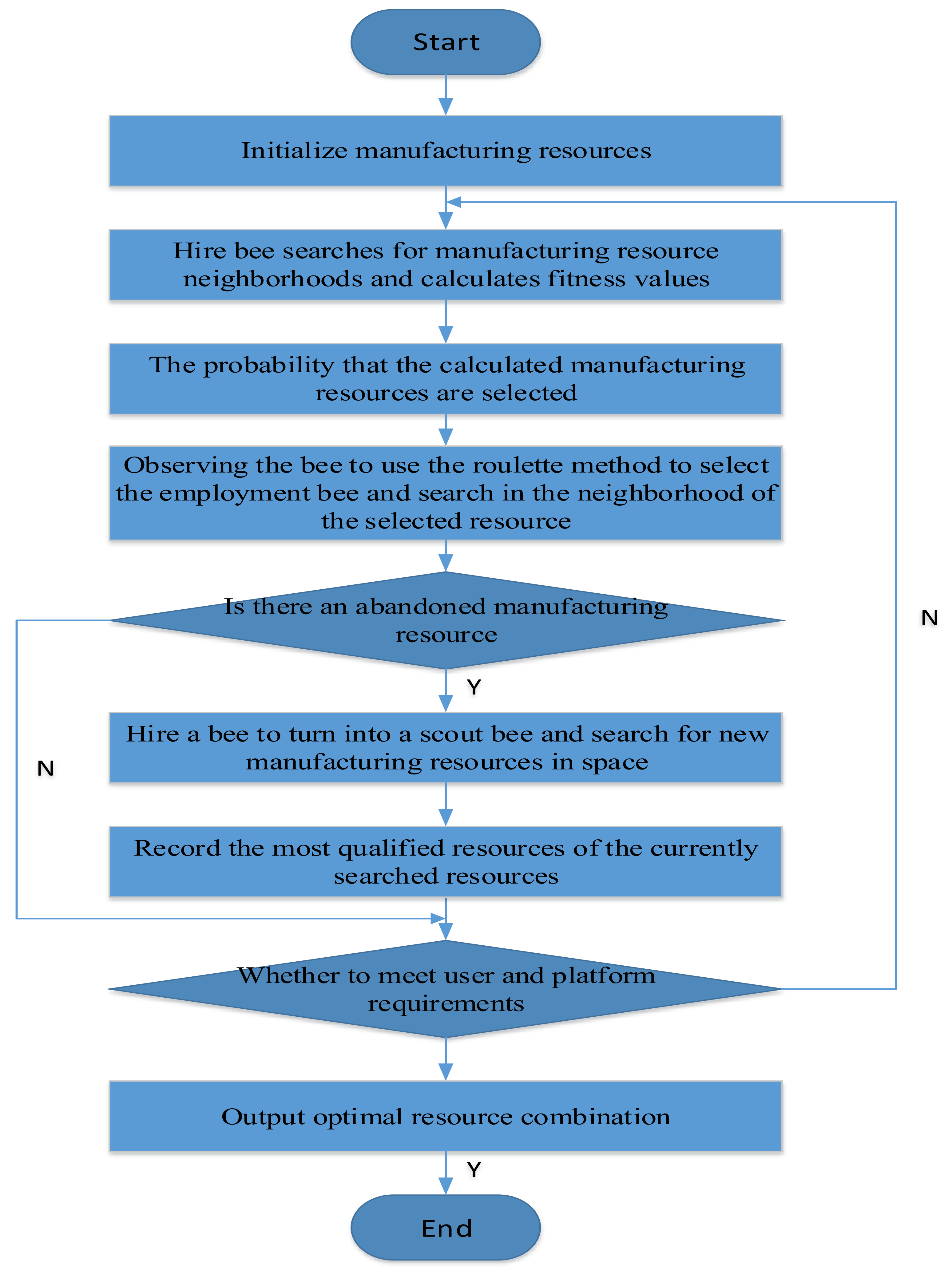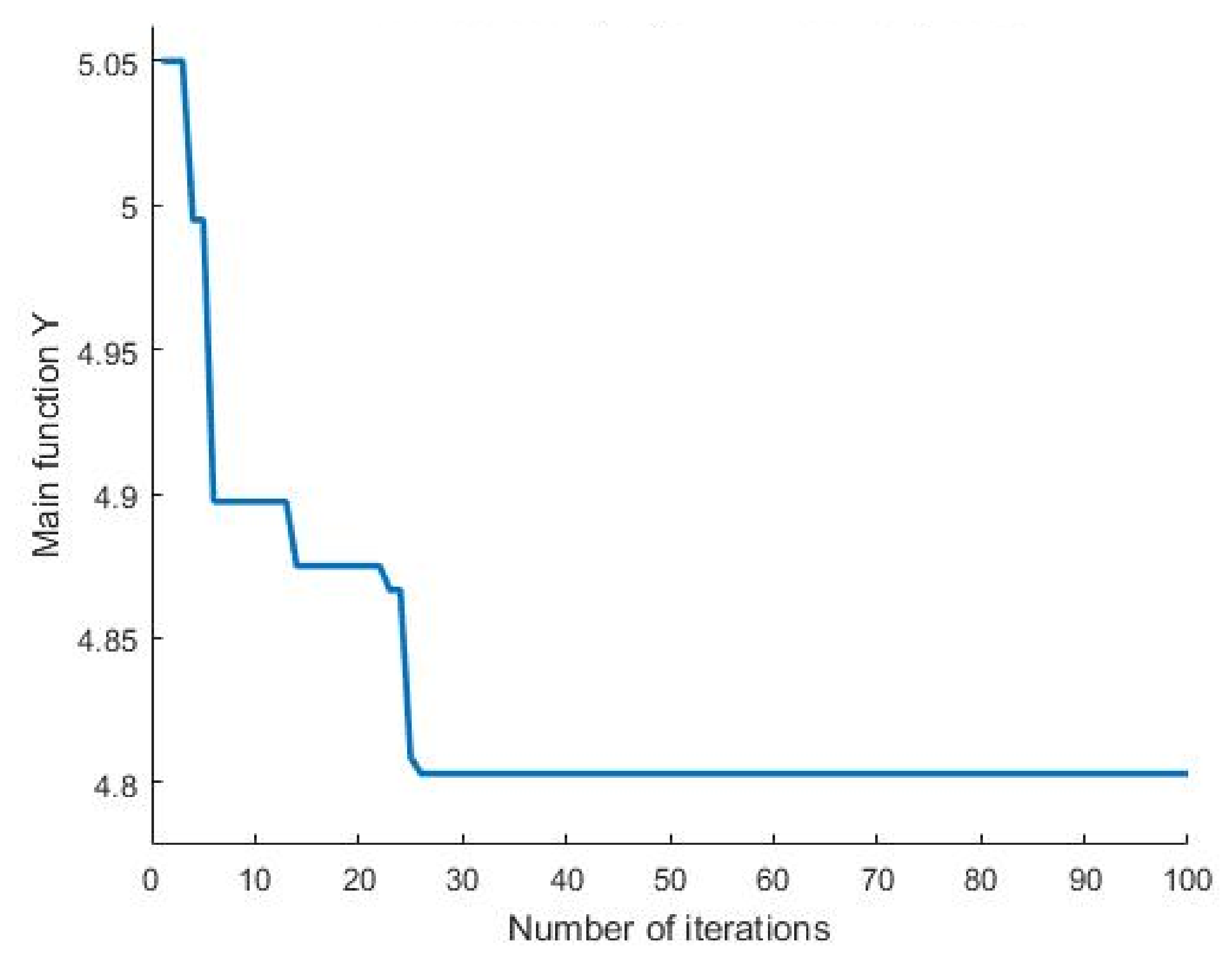Matching of Manufacturing Resources in Cloud Manufacturing Environment
Abstract
:1. Introduction
2. Cloud Manufacturing Resource Classification
3. Matching Problem of Cloud Manufacturing Resources
3.1. Matching of Resources and Manufacturing Task Requiring a Single Resource
3.2. Matching of Resources and Manufacturing Task Requiring Multiple Resources
4. Matching Model
- (1)
- The cloud platform provides a set of candidate resources for manufacturing tasks requiring a single resource by analyzing the constraints of manufacturing resources and the basic attributes, state attributes, and functional attributes of the manufacturing resources. This process is a primary selection process of resource matching. The purpose is not to match a unique service resource for each manufacturing task that requires a single resource, but to search for a service resource whose condition meets the requirements, and to divide the resources that meet the user requirement into the candidate resource set from the massive service resource.
- (2)
- A manufacturing task requiring a single resource searches for a resource matching the user requirement in the candidate resource set, and determines the candidate service by analyzing the time T, quality Q, cost C, reliability Re, and recoverability G of the resource. Then, whether the resource matches the manufacturing task that requires a single resource is determined. If the resource can be matched, it is left; if there is no match, the candidate service resource is deleted from the candidate resource set. When the search match is over, the manufacturing resource that best meets the requirements to serve the user is selected.
4.1. Matching Objective Function
- (1)
- Time T
- (2)
- Quality Q
- (3)
- Cost C
- (4)
- Reliability Re
- (5)
- Recoverability G
4.2. Constraints
- (1)
- Total time constraint
- (2)
- Total quality constraint
- (3)
- Total cost constraint
- (4)
- Reliability constraint
- (5)
- Recoverability constraint
5. Case Analysis
5.1. Determination of Weighting Factor by Analytic Hierarchy Process (AHP)
5.2. Algorithm Solution
6. Discussion
7. Conclusions
Author Contributions
Funding
Institutional Review Board Statement
Informed Consent Statement
Data Availability Statement
Acknowledgments
Conflicts of Interest
References
- Li, X.; Zhuang, P.; Yin, C. A metadata based manufacturing resource ontology modeling in cloud manufacturing systems. J. Ambient. Intell. Humaniz. Comput. 2019, 10, 1039–1047. [Google Scholar] [CrossRef]
- Fu, J. A practical resource-searching method for manufacturing grid. Int. J. Adv. Manuf. Technol. 2014, 74, 335–340. [Google Scholar] [CrossRef] [Green Version]
- Li, B.H.; Zhang, L.; Wang, S.L.; Tao, F.; Cao, J.W.; Jiang, X.D.; Song, X.; Chai, X.D. Cloud manufacturing: A new service-oriented networked manufacturing model. Comput. Integr. Manuf. Syst. 2010, 16, 1–7. (In Chinese) [Google Scholar] [CrossRef]
- Zhang, L.; Luo, Y.L.; Tao, F.; Ren, L.; Guo, H. Key technologies for the construction of manufacturing cloud. Comput. Integr. Manuf. Syst. 2010, 16, 2510–2520. (In Chinese) [Google Scholar] [CrossRef]
- Zhou, J.; Wang, M. Cloud Manufacturing Service Paradigm for Group Manufacturing Companies. Adv. Mech. Eng. 2014, 6, 740725. [Google Scholar] [CrossRef] [Green Version]
- Jin, H.; Fu, Y.; Yang, G.; Zhu, X. An intelligent scheduling algorithm for resource management of cloud platform. Multimed. Tools Appl. 2020, 79, 5335–5353. [Google Scholar] [CrossRef]
- Gong, X.; Yin, C.; Li, X. A grey correlation based supply–demand matching of machine tools with multiple quality factors in cloud manufacturing environment. Ambient. Intell. Humaniz. Comput. 2019, 10, 1025–1038. [Google Scholar] [CrossRef]
- Cheng, Y.; Tao, F.; Zhao, D.M.; Zhang, L. Modeling of manufacturing service supply–demand matching hyper network in service-oriented manufacturing systems. Robot. Comput.-Integr. Manuf. 2017, 45, 59–72. [Google Scholar] [CrossRef]
- Pan, X.Y.; Ma, J.Z.; Zhao, D.Z. Study on pricing behaviour and capacity allocation of cloud manufacturing service platform. Clust. Comput. 2019, 22, 14701–14707. [Google Scholar] [CrossRef]
- Laili, Y.; Tao, F.; Zhang, L.; Sarker, B.R. A study of optimal allocation of computing resources in cloud manufacturing systems. Int. J. Adv. Manuf. Technol. 2012, 63, 671–690. [Google Scholar] [CrossRef]
- Sheng, B.; Zhang, C.; Yin, X.; Lu, Q.; Cheng, Y.; Xiao, T.; Liu, H. Common intelligent semantic matching engines of cloud manufacturing service based on OWL-S. Int. J. Adv. Manuf. Technol. 2016, 84, 103–118. [Google Scholar] [CrossRef]
- Morariu, O.; Borangiu, T.; Morariu, C.; Răileanu, S. Service Oriented Mechanisms for Smart Resource Allocation in Private Manufacturing Clouds. In Proceedings of the International Conference on Exploring Services Science, Bucharest, Romania, 25–27 May 2016. [Google Scholar] [CrossRef]
- Zheng, H.; Feng, Y.; Tan, J. A fuzzy QoS-aware resource service selection considering design preference in cloud manufacturing system. Int. J. Adv. Manuf. Technol. 2016, 84, 371–379. [Google Scholar] [CrossRef]
- Guo, Y.; Xie, S. Modeling Method of Resource Combination Optimization for Crowdsourcing Product Development Based on Cloud. In Proceedings of the International Conference on Mechanical Design, Beijing, China, 13–15 October 2017. [Google Scholar] [CrossRef]
- Hu, Y.J.; Chang, X.F.; Wang, Y.; Wang, Z.L.; Shi, C.; Wu, L.Z. Cloud manufacturing resources fuzzy classification based on genetic simulated annealing algorithm. Mater. Manuf. Process. 2017, 32, 1109–1115. [Google Scholar] [CrossRef]
- Tao, F.; Li, C.; Liao, T.W.; Laili, Y. BGM-BLA: A New Algorithm for Dynamic Migration of Virtual Machines in Cloud Computing. IEEE Trans. Serv. Comput. 2016, 9, 910–925. [Google Scholar] [CrossRef]
- Cao, Y.; Wu, Z.; Liu, T.; Gao, Z.; Yang, J. Multivariate process capability evaluation of cloud manufacturing resource based on intuitionistic fuzzy set. Int. J. Adv. Manuf. Technol. 2016, 84, 227–237. [Google Scholar] [CrossRef]
- Guo, L.; Qiu, J. Optimization technology in cloud manufacturing. Int. J. Adv. Manuf. Technol. 2018, 97, 1181–1193. [Google Scholar] [CrossRef]
- Li, F.; Zhang, L.; Liu, Y.K.; Laili, Y.; Tao, F. A clustering network-based approach to service composition in cloud manufacturing. Int. J. Comput. Integr. Manuf. 2017, 30, 1331–1342. [Google Scholar] [CrossRef]
- Song, T.; Liu, H.; Wei, C.; Zhang, C. Common engines of cloud manufacturing service platform for SMEs. Int. J. Adv. Manuf. Technol. 2014, 73, 557–569. [Google Scholar] [CrossRef]
- Zhou, L.F.; Zhang, L.; Laili, Y.J.; Zhao, C.; Xiao, Y.Y. Multi-task scheduling of distributed 3D printing services in cloud manufacturing. Int. J. Adv. Manuf. Technol. 2018, 96, 3003–3017. [Google Scholar] [CrossRef]
- Tasgetiren, M.F.; Pan, Q.K. A discrete artificial bee colony algorithm for the total flowtime minimization in permutation flow shops. Inf. Sci. 2011, 181, 3459–3475. [Google Scholar] [CrossRef]
- Li, H.; Li, W. Enhanced artificial bee Colony algorithm and its application in multi-threshold image feature retrieval. Multimed. Tools Appl. 2019, 78, 8683–8698. [Google Scholar] [CrossRef]




| Physical Quantity | Meaning |
|---|---|
| Candidate resource set | |
| A single resource manufacturing task | |
| Task acceptance time | |
| Hard resources (transport time of physical resources such as device resources) | |
| Soft resources (authorization of patent use, waiting time for debugging of software) | |
| Resource service time | |
| Waiting time factor | |
| Transport time factor | |
| Number of matching resources | |
| The jth candidate service resource for the ith manufacturing task | |
| Evaluation of the jth quality indicator after the user obtains the ith resource | |
| Quality of service for hard resources | |
| Quality of service for soft resources | |
| Quality of service for other resources | |
| Quality of service factor for hard resources | |
| Quality of service factor of soft resources | |
| Quality of service factor for other resources | |
| Number of user reviews | |
| Cost of hard resources | |
| Cost of soft resources | |
| Fees paid after using hard resources | |
| Shipping costs paid after using hard resources | |
| Fees paid after using soft resources | |
| Resource failure rate | |
| Resource fault tolerance | |
| Resource security | |
| the number of times that the service resource has resumed working after it stopped working due to an unexpected condition | |
| Number of unexpected conditions |
| Subtasks | ||||||
| Candidate resource set | ||||||
| — | ||||||
| — | — | — | ||||
| — | — | — | — | — |
| Resource | T | C | Q | Re | G |
|---|---|---|---|---|---|
| 80 | 28 | 58.00 | 53.85 | 28 | |
| 25 | 26 | 58.70 | 53.80 | 28 | |
| 85 | 27 | 54.90 | 56.55 | 29 | |
| 51 | 24 | 57.70 | 55.75 | 28 | |
| 83 | 24 | 57.80 | 56.95 | 30 | |
| 86 | 22 | 56.80 | 55.85 | 28 | |
| 62 | 25 | 54.80 | 54.85 | 27 | |
| 46 | 26 | 56.70 | 54.55 | 29 | |
| 49 | 25 | 55.00 | 54.65 | 32 | |
| 82 | 28 | 55.70 | 56.80 | 27 | |
| 63 | 23 | 59.80 | 54.60 | 30 | |
| 83 | 24 | 56.80 | 53.65 | 30 | |
| 82 | 28 | 55.80 | 55.60 | 29 | |
| 85 | 25 | 56.90 | 56.75 | 32 | |
| 75 | 23 | 58.00 | 54.90 | 28 | |
| 80 | 26 | 54.80 | 54.00 | 29 | |
| 61 | 22 | 58.80 | 54.90 | 30 | |
| 86 | 25 | 58.00 | 53.50 | 27 | |
| 80 | 28 | 54.80 | 55.70 | 28 | |
| 83 | 22 | 57.80 | 54.55 | 29 | |
| 47 | 25 | 55.00 | 53.60 | 27 | |
| 87 | 27 | 54.80 | 54.60 | 27 | |
| 83 | 27 | 57.90 | 54.65 | 30 | |
| 46 | 26 | 58.70 | 55.90 | 29 | |
| 62 | 26 | 56.90 | 54.90 | 28 | |
| 53 | 26 | 55.80 | 54.00 | 31 | |
| 74 | 23 | 55.90 | 55.55 | 27 |
| Index | T | C | Q | Re | G |
|---|---|---|---|---|---|
| weighting | 0.4237 | 0.2274 | 0.1422 | 0.1772 | 0.0294 |
| Subtasks | ||||||
| Optimal resource |
Publisher’s Note: MDPI stays neutral with regard to jurisdictional claims in published maps and institutional affiliations. |
© 2021 by the authors. Licensee MDPI, Basel, Switzerland. This article is an open access article distributed under the terms and conditions of the Creative Commons Attribution (CC BY) license (https://creativecommons.org/licenses/by/4.0/).
Share and Cite
Hu, Y.; Pan, L.; Gu, D.; Wang, Z.; Liu, H.; Wang, Y. Matching of Manufacturing Resources in Cloud Manufacturing Environment. Symmetry 2021, 13, 1970. https://doi.org/10.3390/sym13101970
Hu Y, Pan L, Gu D, Wang Z, Liu H, Wang Y. Matching of Manufacturing Resources in Cloud Manufacturing Environment. Symmetry. 2021; 13(10):1970. https://doi.org/10.3390/sym13101970
Chicago/Turabian StyleHu, Yanjuan, Leiting Pan, Dongwei Gu, Zhanli Wang, Hongliang Liu, and Yilin Wang. 2021. "Matching of Manufacturing Resources in Cloud Manufacturing Environment" Symmetry 13, no. 10: 1970. https://doi.org/10.3390/sym13101970
APA StyleHu, Y., Pan, L., Gu, D., Wang, Z., Liu, H., & Wang, Y. (2021). Matching of Manufacturing Resources in Cloud Manufacturing Environment. Symmetry, 13(10), 1970. https://doi.org/10.3390/sym13101970





